Intercultural Competence: Theories, Practices, and Reflection Essay
VerifiedAdded on 2023/04/10
|11
|2888
|320
Essay
AI Summary
This essay delves into the development of intercultural competence, using personal experiences and theoretical frameworks to explore effective cross-cultural communication. The author, with an African background and studying in Australia, reflects on the challenges and strategies for building intercultural competence. The essay discusses the role of intercultural competence in public relations and international campaigns, examining how cultural background shapes attitudes and expectations. It utilizes Gibb’s reflection cycle and Hofstede’s cultural dimensions to analyze personal development and approach international campaigns with cultural sensitivity. The author highlights key components of intercultural competence, including mindfulness, cognitive flexibility, tolerance for ambiguity, behavioral flexibility, and cross-cultural empathy. The essay emphasizes the importance of cultural awareness, language proficiency, and creating a positive team culture in international campaigns to achieve successful outcomes.
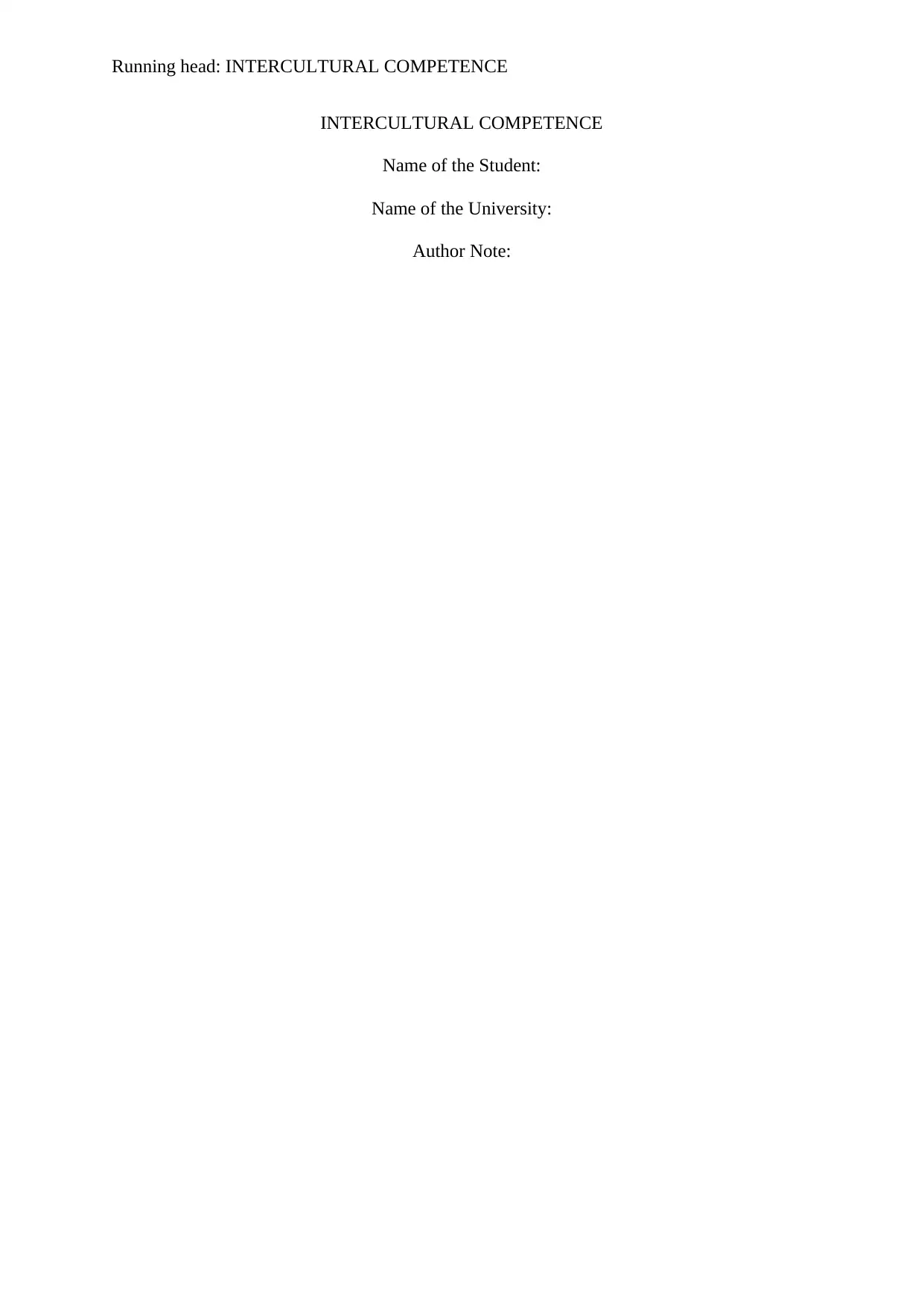
Running head: INTERCULTURAL COMPETENCE
INTERCULTURAL COMPETENCE
Name of the Student:
Name of the University:
Author Note:
INTERCULTURAL COMPETENCE
Name of the Student:
Name of the University:
Author Note:
Paraphrase This Document
Need a fresh take? Get an instant paraphrase of this document with our AI Paraphraser
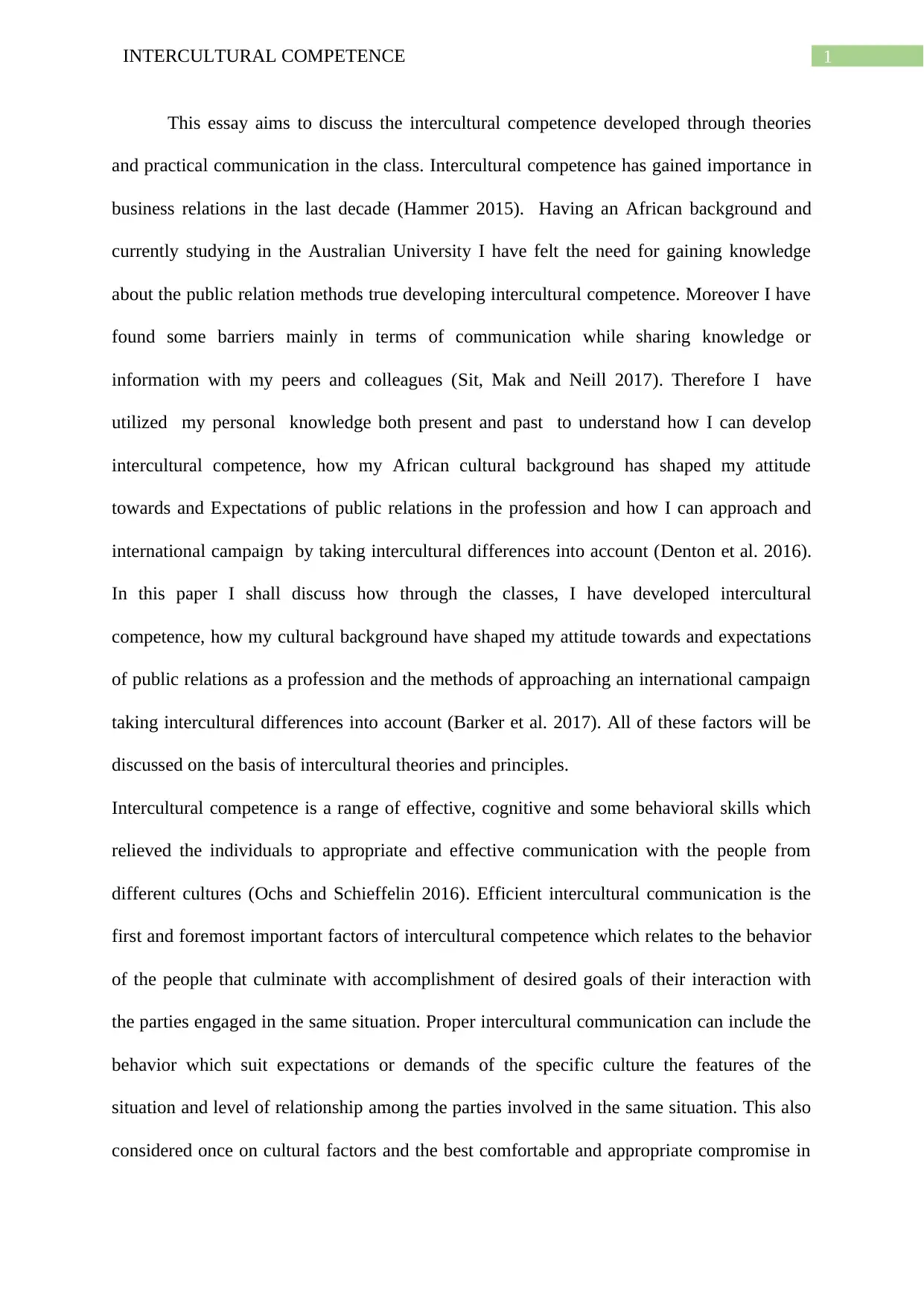
1INTERCULTURAL COMPETENCE
This essay aims to discuss the intercultural competence developed through theories
and practical communication in the class. Intercultural competence has gained importance in
business relations in the last decade (Hammer 2015). Having an African background and
currently studying in the Australian University I have felt the need for gaining knowledge
about the public relation methods true developing intercultural competence. Moreover I have
found some barriers mainly in terms of communication while sharing knowledge or
information with my peers and colleagues (Sit, Mak and Neill 2017). Therefore I have
utilized my personal knowledge both present and past to understand how I can develop
intercultural competence, how my African cultural background has shaped my attitude
towards and Expectations of public relations in the profession and how I can approach and
international campaign by taking intercultural differences into account (Denton et al. 2016).
In this paper I shall discuss how through the classes, I have developed intercultural
competence, how my cultural background have shaped my attitude towards and expectations
of public relations as a profession and the methods of approaching an international campaign
taking intercultural differences into account (Barker et al. 2017). All of these factors will be
discussed on the basis of intercultural theories and principles.
Intercultural competence is a range of effective, cognitive and some behavioral skills which
relieved the individuals to appropriate and effective communication with the people from
different cultures (Ochs and Schieffelin 2016). Efficient intercultural communication is the
first and foremost important factors of intercultural competence which relates to the behavior
of the people that culminate with accomplishment of desired goals of their interaction with
the parties engaged in the same situation. Proper intercultural communication can include the
behavior which suit expectations or demands of the specific culture the features of the
situation and level of relationship among the parties involved in the same situation. This also
considered once on cultural factors and the best comfortable and appropriate compromise in
This essay aims to discuss the intercultural competence developed through theories
and practical communication in the class. Intercultural competence has gained importance in
business relations in the last decade (Hammer 2015). Having an African background and
currently studying in the Australian University I have felt the need for gaining knowledge
about the public relation methods true developing intercultural competence. Moreover I have
found some barriers mainly in terms of communication while sharing knowledge or
information with my peers and colleagues (Sit, Mak and Neill 2017). Therefore I have
utilized my personal knowledge both present and past to understand how I can develop
intercultural competence, how my African cultural background has shaped my attitude
towards and Expectations of public relations in the profession and how I can approach and
international campaign by taking intercultural differences into account (Denton et al. 2016).
In this paper I shall discuss how through the classes, I have developed intercultural
competence, how my cultural background have shaped my attitude towards and expectations
of public relations as a profession and the methods of approaching an international campaign
taking intercultural differences into account (Barker et al. 2017). All of these factors will be
discussed on the basis of intercultural theories and principles.
Intercultural competence is a range of effective, cognitive and some behavioral skills which
relieved the individuals to appropriate and effective communication with the people from
different cultures (Ochs and Schieffelin 2016). Efficient intercultural communication is the
first and foremost important factors of intercultural competence which relates to the behavior
of the people that culminate with accomplishment of desired goals of their interaction with
the parties engaged in the same situation. Proper intercultural communication can include the
behavior which suit expectations or demands of the specific culture the features of the
situation and level of relationship among the parties involved in the same situation. This also
considered once on cultural factors and the best comfortable and appropriate compromise in
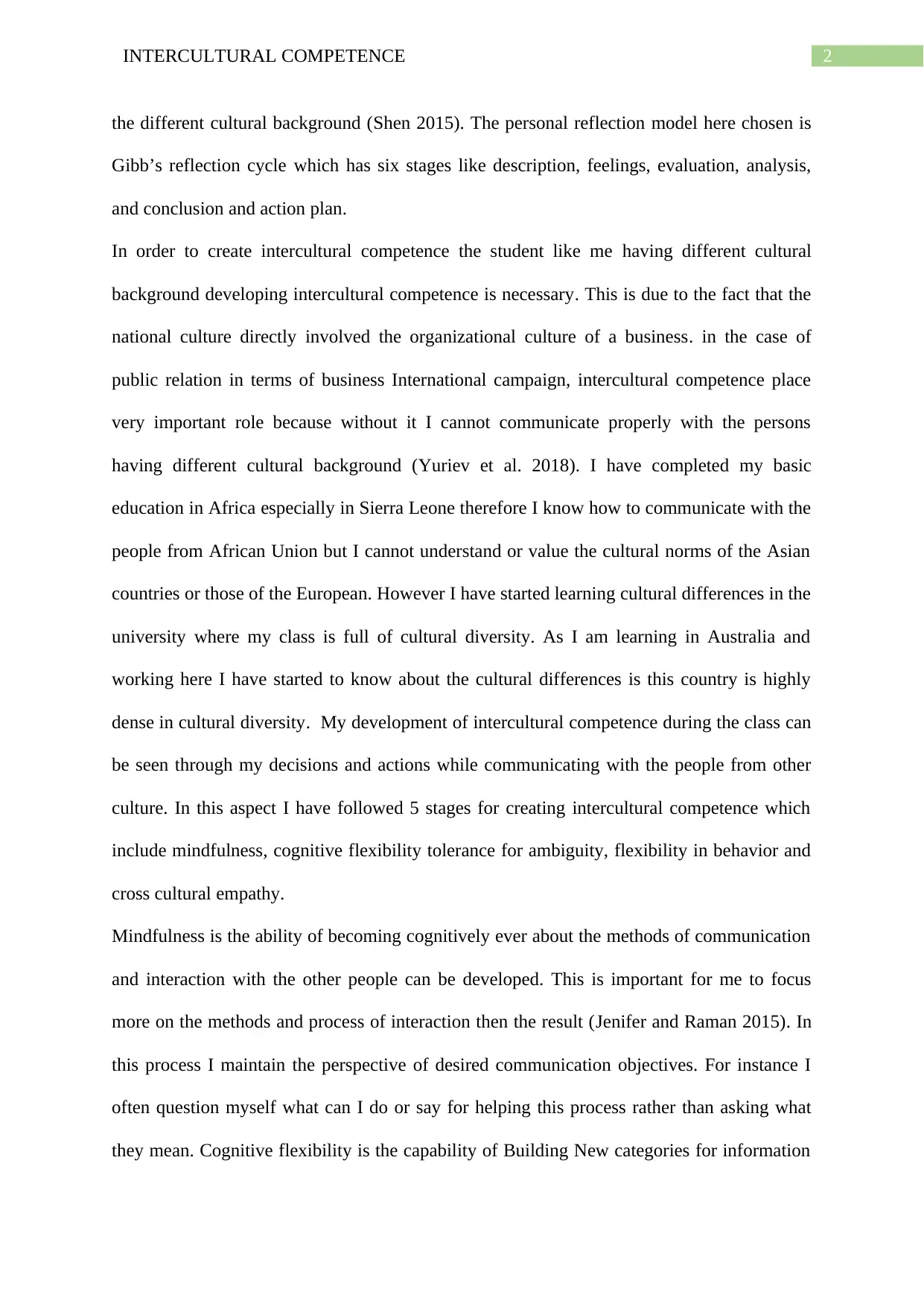
2INTERCULTURAL COMPETENCE
the different cultural background (Shen 2015). The personal reflection model here chosen is
Gibb’s reflection cycle which has six stages like description, feelings, evaluation, analysis,
and conclusion and action plan.
In order to create intercultural competence the student like me having different cultural
background developing intercultural competence is necessary. This is due to the fact that the
national culture directly involved the organizational culture of a business. in the case of
public relation in terms of business International campaign, intercultural competence place
very important role because without it I cannot communicate properly with the persons
having different cultural background (Yuriev et al. 2018). I have completed my basic
education in Africa especially in Sierra Leone therefore I know how to communicate with the
people from African Union but I cannot understand or value the cultural norms of the Asian
countries or those of the European. However I have started learning cultural differences in the
university where my class is full of cultural diversity. As I am learning in Australia and
working here I have started to know about the cultural differences is this country is highly
dense in cultural diversity. My development of intercultural competence during the class can
be seen through my decisions and actions while communicating with the people from other
culture. In this aspect I have followed 5 stages for creating intercultural competence which
include mindfulness, cognitive flexibility tolerance for ambiguity, flexibility in behavior and
cross cultural empathy.
Mindfulness is the ability of becoming cognitively ever about the methods of communication
and interaction with the other people can be developed. This is important for me to focus
more on the methods and process of interaction then the result (Jenifer and Raman 2015). In
this process I maintain the perspective of desired communication objectives. For instance I
often question myself what can I do or say for helping this process rather than asking what
they mean. Cognitive flexibility is the capability of Building New categories for information
the different cultural background (Shen 2015). The personal reflection model here chosen is
Gibb’s reflection cycle which has six stages like description, feelings, evaluation, analysis,
and conclusion and action plan.
In order to create intercultural competence the student like me having different cultural
background developing intercultural competence is necessary. This is due to the fact that the
national culture directly involved the organizational culture of a business. in the case of
public relation in terms of business International campaign, intercultural competence place
very important role because without it I cannot communicate properly with the persons
having different cultural background (Yuriev et al. 2018). I have completed my basic
education in Africa especially in Sierra Leone therefore I know how to communicate with the
people from African Union but I cannot understand or value the cultural norms of the Asian
countries or those of the European. However I have started learning cultural differences in the
university where my class is full of cultural diversity. As I am learning in Australia and
working here I have started to know about the cultural differences is this country is highly
dense in cultural diversity. My development of intercultural competence during the class can
be seen through my decisions and actions while communicating with the people from other
culture. In this aspect I have followed 5 stages for creating intercultural competence which
include mindfulness, cognitive flexibility tolerance for ambiguity, flexibility in behavior and
cross cultural empathy.
Mindfulness is the ability of becoming cognitively ever about the methods of communication
and interaction with the other people can be developed. This is important for me to focus
more on the methods and process of interaction then the result (Jenifer and Raman 2015). In
this process I maintain the perspective of desired communication objectives. For instance I
often question myself what can I do or say for helping this process rather than asking what
they mean. Cognitive flexibility is the capability of Building New categories for information
⊘ This is a preview!⊘
Do you want full access?
Subscribe today to unlock all pages.

Trusted by 1+ million students worldwide
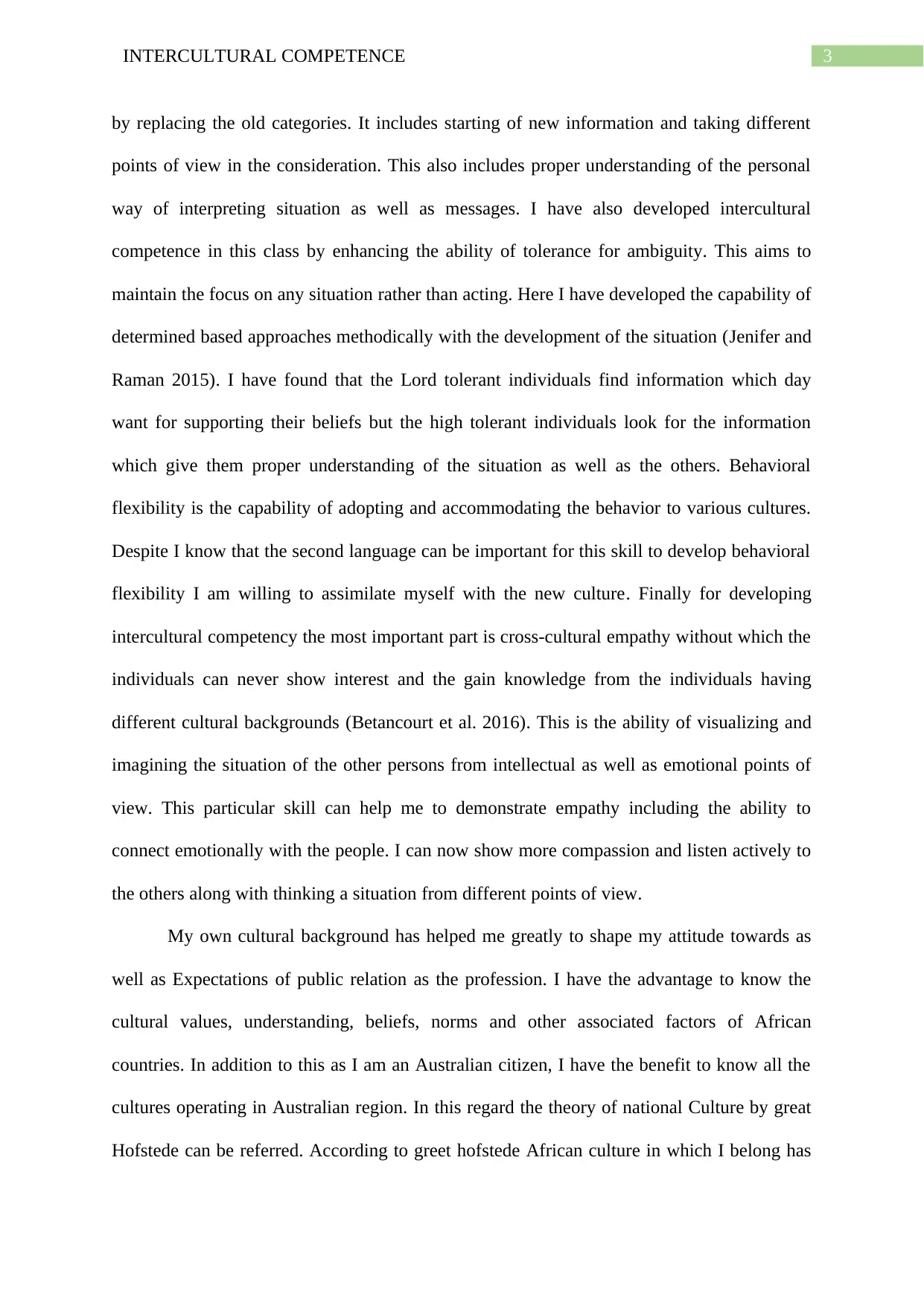
3INTERCULTURAL COMPETENCE
by replacing the old categories. It includes starting of new information and taking different
points of view in the consideration. This also includes proper understanding of the personal
way of interpreting situation as well as messages. I have also developed intercultural
competence in this class by enhancing the ability of tolerance for ambiguity. This aims to
maintain the focus on any situation rather than acting. Here I have developed the capability of
determined based approaches methodically with the development of the situation (Jenifer and
Raman 2015). I have found that the Lord tolerant individuals find information which day
want for supporting their beliefs but the high tolerant individuals look for the information
which give them proper understanding of the situation as well as the others. Behavioral
flexibility is the capability of adopting and accommodating the behavior to various cultures.
Despite I know that the second language can be important for this skill to develop behavioral
flexibility I am willing to assimilate myself with the new culture. Finally for developing
intercultural competency the most important part is cross-cultural empathy without which the
individuals can never show interest and the gain knowledge from the individuals having
different cultural backgrounds (Betancourt et al. 2016). This is the ability of visualizing and
imagining the situation of the other persons from intellectual as well as emotional points of
view. This particular skill can help me to demonstrate empathy including the ability to
connect emotionally with the people. I can now show more compassion and listen actively to
the others along with thinking a situation from different points of view.
My own cultural background has helped me greatly to shape my attitude towards as
well as Expectations of public relation as the profession. I have the advantage to know the
cultural values, understanding, beliefs, norms and other associated factors of African
countries. In addition to this as I am an Australian citizen, I have the benefit to know all the
cultures operating in Australian region. In this regard the theory of national Culture by great
Hofstede can be referred. According to greet hofstede African culture in which I belong has
by replacing the old categories. It includes starting of new information and taking different
points of view in the consideration. This also includes proper understanding of the personal
way of interpreting situation as well as messages. I have also developed intercultural
competence in this class by enhancing the ability of tolerance for ambiguity. This aims to
maintain the focus on any situation rather than acting. Here I have developed the capability of
determined based approaches methodically with the development of the situation (Jenifer and
Raman 2015). I have found that the Lord tolerant individuals find information which day
want for supporting their beliefs but the high tolerant individuals look for the information
which give them proper understanding of the situation as well as the others. Behavioral
flexibility is the capability of adopting and accommodating the behavior to various cultures.
Despite I know that the second language can be important for this skill to develop behavioral
flexibility I am willing to assimilate myself with the new culture. Finally for developing
intercultural competency the most important part is cross-cultural empathy without which the
individuals can never show interest and the gain knowledge from the individuals having
different cultural backgrounds (Betancourt et al. 2016). This is the ability of visualizing and
imagining the situation of the other persons from intellectual as well as emotional points of
view. This particular skill can help me to demonstrate empathy including the ability to
connect emotionally with the people. I can now show more compassion and listen actively to
the others along with thinking a situation from different points of view.
My own cultural background has helped me greatly to shape my attitude towards as
well as Expectations of public relation as the profession. I have the advantage to know the
cultural values, understanding, beliefs, norms and other associated factors of African
countries. In addition to this as I am an Australian citizen, I have the benefit to know all the
cultures operating in Australian region. In this regard the theory of national Culture by great
Hofstede can be referred. According to greet hofstede African culture in which I belong has
Paraphrase This Document
Need a fresh take? Get an instant paraphrase of this document with our AI Paraphraser
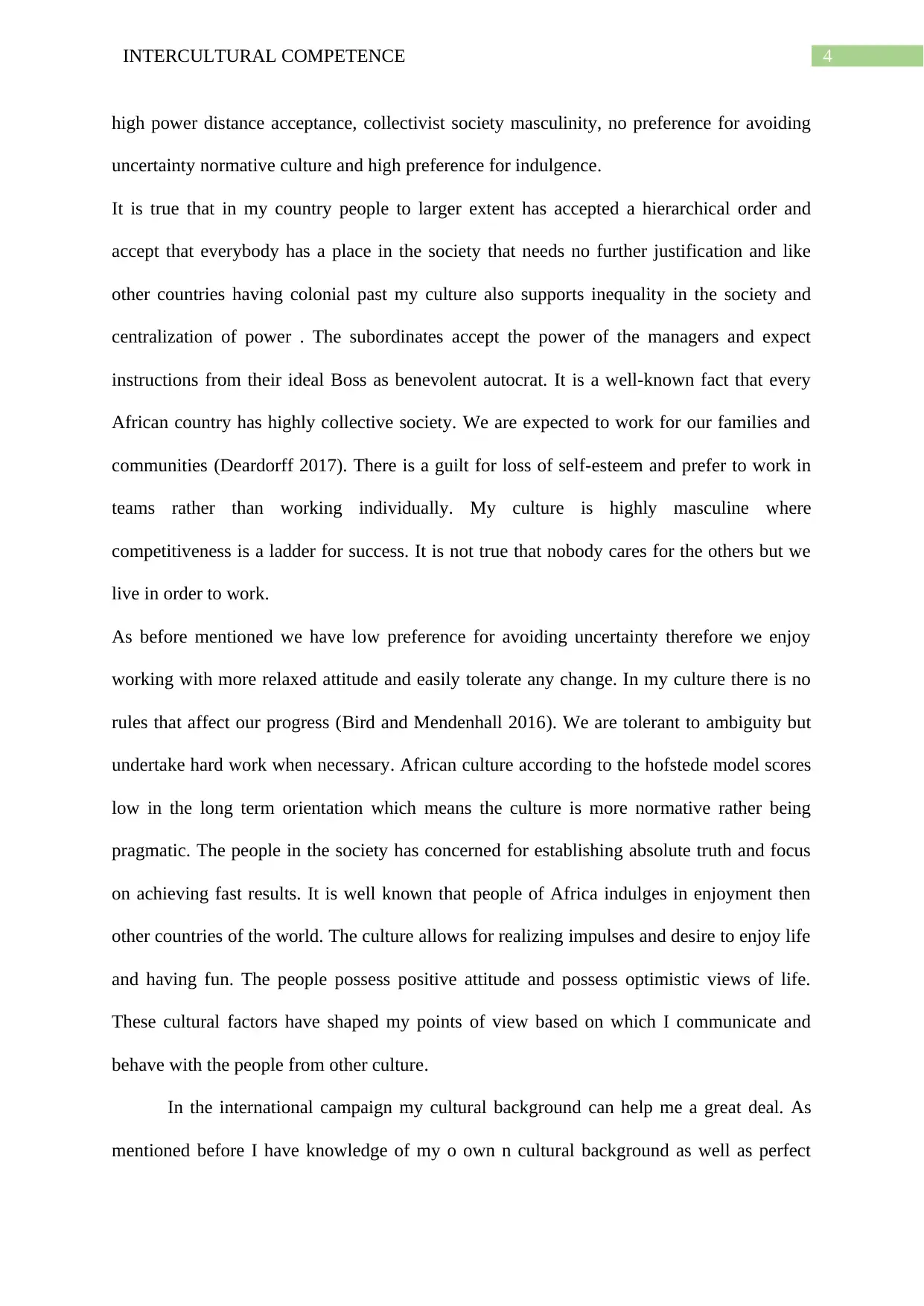
4INTERCULTURAL COMPETENCE
high power distance acceptance, collectivist society masculinity, no preference for avoiding
uncertainty normative culture and high preference for indulgence.
It is true that in my country people to larger extent has accepted a hierarchical order and
accept that everybody has a place in the society that needs no further justification and like
other countries having colonial past my culture also supports inequality in the society and
centralization of power . The subordinates accept the power of the managers and expect
instructions from their ideal Boss as benevolent autocrat. It is a well-known fact that every
African country has highly collective society. We are expected to work for our families and
communities (Deardorff 2017). There is a guilt for loss of self-esteem and prefer to work in
teams rather than working individually. My culture is highly masculine where
competitiveness is a ladder for success. It is not true that nobody cares for the others but we
live in order to work.
As before mentioned we have low preference for avoiding uncertainty therefore we enjoy
working with more relaxed attitude and easily tolerate any change. In my culture there is no
rules that affect our progress (Bird and Mendenhall 2016). We are tolerant to ambiguity but
undertake hard work when necessary. African culture according to the hofstede model scores
low in the long term orientation which means the culture is more normative rather being
pragmatic. The people in the society has concerned for establishing absolute truth and focus
on achieving fast results. It is well known that people of Africa indulges in enjoyment then
other countries of the world. The culture allows for realizing impulses and desire to enjoy life
and having fun. The people possess positive attitude and possess optimistic views of life.
These cultural factors have shaped my points of view based on which I communicate and
behave with the people from other culture.
In the international campaign my cultural background can help me a great deal. As
mentioned before I have knowledge of my o own n cultural background as well as perfect
high power distance acceptance, collectivist society masculinity, no preference for avoiding
uncertainty normative culture and high preference for indulgence.
It is true that in my country people to larger extent has accepted a hierarchical order and
accept that everybody has a place in the society that needs no further justification and like
other countries having colonial past my culture also supports inequality in the society and
centralization of power . The subordinates accept the power of the managers and expect
instructions from their ideal Boss as benevolent autocrat. It is a well-known fact that every
African country has highly collective society. We are expected to work for our families and
communities (Deardorff 2017). There is a guilt for loss of self-esteem and prefer to work in
teams rather than working individually. My culture is highly masculine where
competitiveness is a ladder for success. It is not true that nobody cares for the others but we
live in order to work.
As before mentioned we have low preference for avoiding uncertainty therefore we enjoy
working with more relaxed attitude and easily tolerate any change. In my culture there is no
rules that affect our progress (Bird and Mendenhall 2016). We are tolerant to ambiguity but
undertake hard work when necessary. African culture according to the hofstede model scores
low in the long term orientation which means the culture is more normative rather being
pragmatic. The people in the society has concerned for establishing absolute truth and focus
on achieving fast results. It is well known that people of Africa indulges in enjoyment then
other countries of the world. The culture allows for realizing impulses and desire to enjoy life
and having fun. The people possess positive attitude and possess optimistic views of life.
These cultural factors have shaped my points of view based on which I communicate and
behave with the people from other culture.
In the international campaign my cultural background can help me a great deal. As
mentioned before I have knowledge of my o own n cultural background as well as perfect
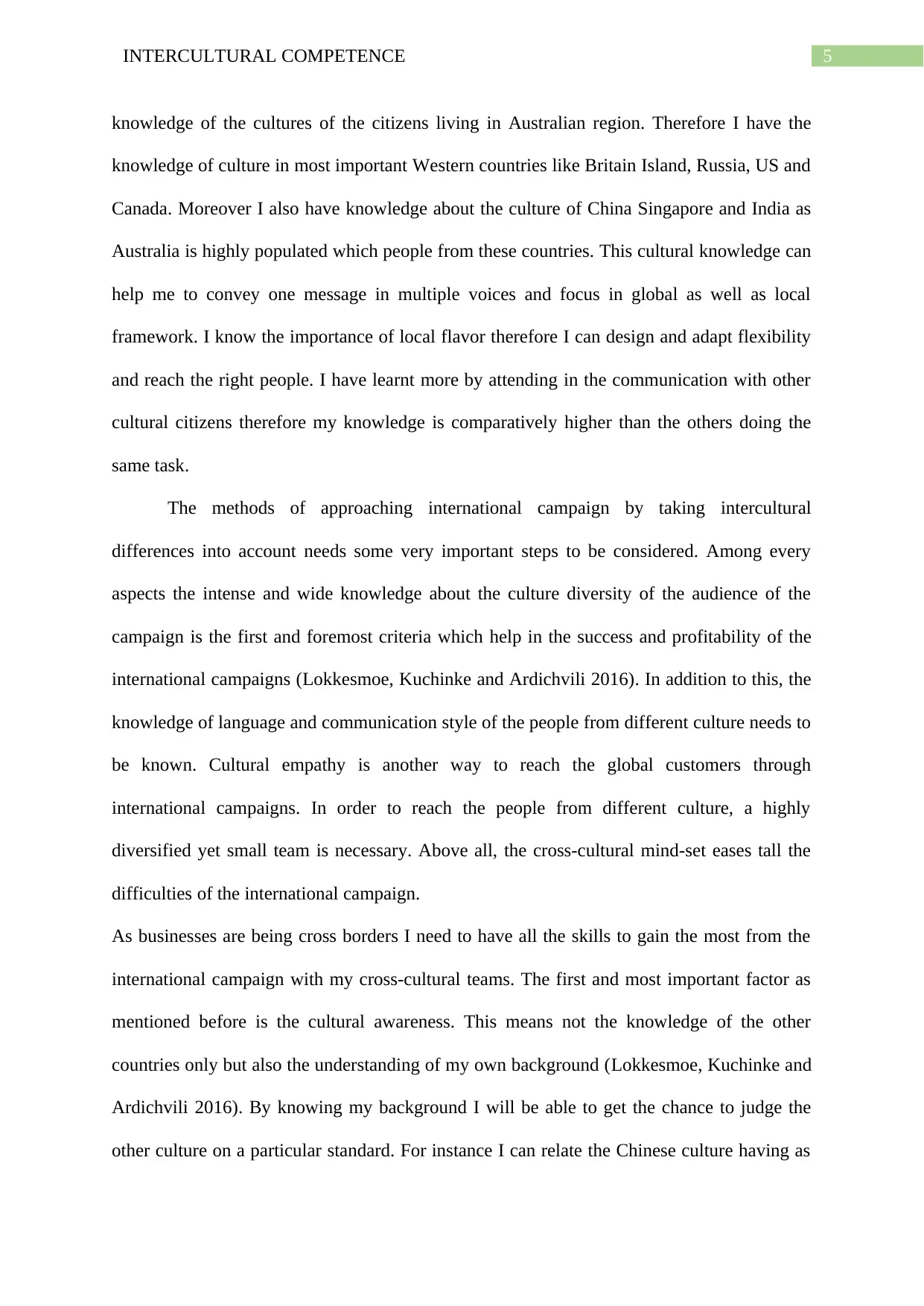
5INTERCULTURAL COMPETENCE
knowledge of the cultures of the citizens living in Australian region. Therefore I have the
knowledge of culture in most important Western countries like Britain Island, Russia, US and
Canada. Moreover I also have knowledge about the culture of China Singapore and India as
Australia is highly populated which people from these countries. This cultural knowledge can
help me to convey one message in multiple voices and focus in global as well as local
framework. I know the importance of local flavor therefore I can design and adapt flexibility
and reach the right people. I have learnt more by attending in the communication with other
cultural citizens therefore my knowledge is comparatively higher than the others doing the
same task.
The methods of approaching international campaign by taking intercultural
differences into account needs some very important steps to be considered. Among every
aspects the intense and wide knowledge about the culture diversity of the audience of the
campaign is the first and foremost criteria which help in the success and profitability of the
international campaigns (Lokkesmoe, Kuchinke and Ardichvili 2016). In addition to this, the
knowledge of language and communication style of the people from different culture needs to
be known. Cultural empathy is another way to reach the global customers through
international campaigns. In order to reach the people from different culture, a highly
diversified yet small team is necessary. Above all, the cross-cultural mind-set eases tall the
difficulties of the international campaign.
As businesses are being cross borders I need to have all the skills to gain the most from the
international campaign with my cross-cultural teams. The first and most important factor as
mentioned before is the cultural awareness. This means not the knowledge of the other
countries only but also the understanding of my own background (Lokkesmoe, Kuchinke and
Ardichvili 2016). By knowing my background I will be able to get the chance to judge the
other culture on a particular standard. For instance I can relate the Chinese culture having as
knowledge of the cultures of the citizens living in Australian region. Therefore I have the
knowledge of culture in most important Western countries like Britain Island, Russia, US and
Canada. Moreover I also have knowledge about the culture of China Singapore and India as
Australia is highly populated which people from these countries. This cultural knowledge can
help me to convey one message in multiple voices and focus in global as well as local
framework. I know the importance of local flavor therefore I can design and adapt flexibility
and reach the right people. I have learnt more by attending in the communication with other
cultural citizens therefore my knowledge is comparatively higher than the others doing the
same task.
The methods of approaching international campaign by taking intercultural
differences into account needs some very important steps to be considered. Among every
aspects the intense and wide knowledge about the culture diversity of the audience of the
campaign is the first and foremost criteria which help in the success and profitability of the
international campaigns (Lokkesmoe, Kuchinke and Ardichvili 2016). In addition to this, the
knowledge of language and communication style of the people from different culture needs to
be known. Cultural empathy is another way to reach the global customers through
international campaigns. In order to reach the people from different culture, a highly
diversified yet small team is necessary. Above all, the cross-cultural mind-set eases tall the
difficulties of the international campaign.
As businesses are being cross borders I need to have all the skills to gain the most from the
international campaign with my cross-cultural teams. The first and most important factor as
mentioned before is the cultural awareness. This means not the knowledge of the other
countries only but also the understanding of my own background (Lokkesmoe, Kuchinke and
Ardichvili 2016). By knowing my background I will be able to get the chance to judge the
other culture on a particular standard. For instance I can relate the Chinese culture having as
⊘ This is a preview!⊘
Do you want full access?
Subscribe today to unlock all pages.

Trusted by 1+ million students worldwide
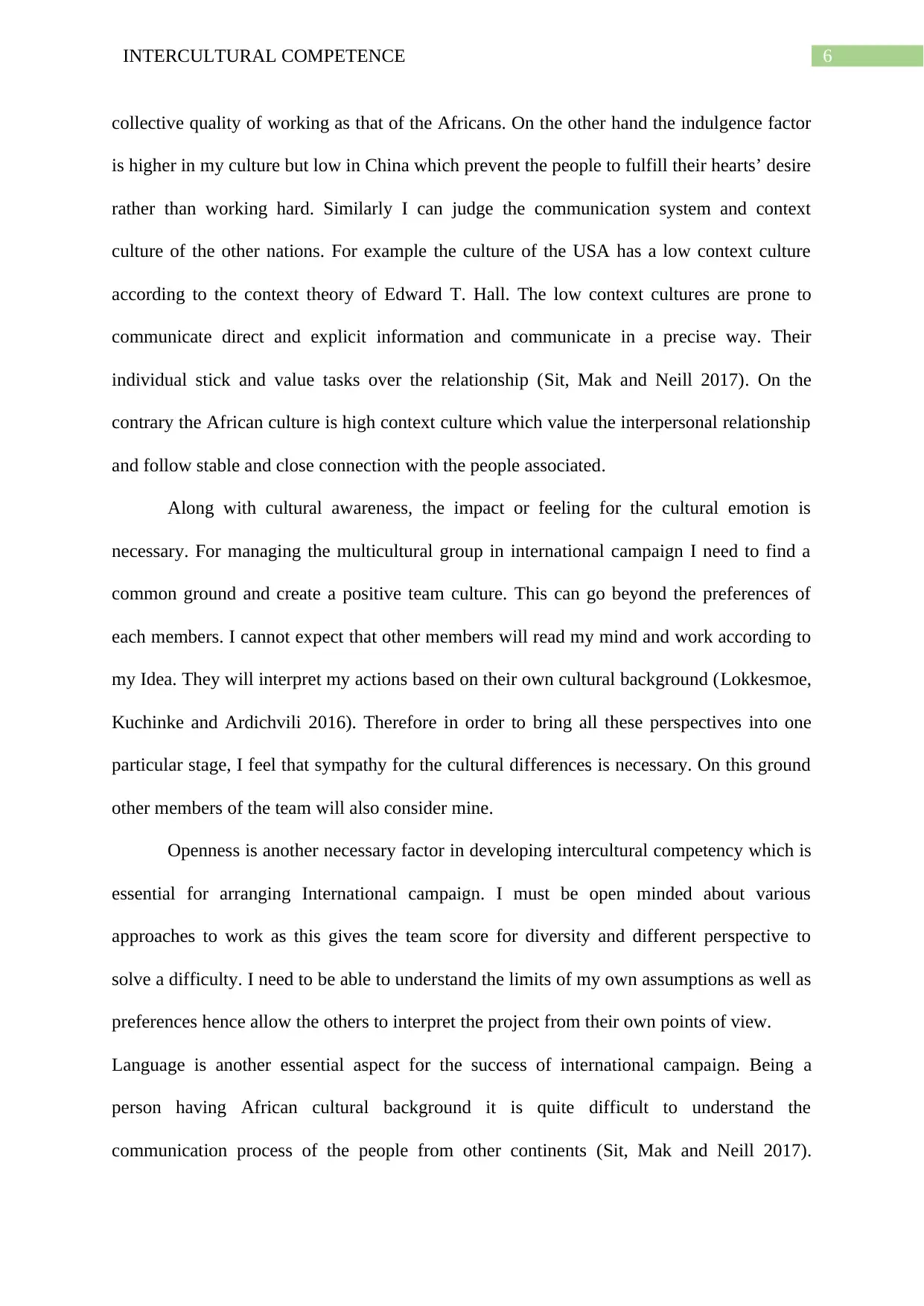
6INTERCULTURAL COMPETENCE
collective quality of working as that of the Africans. On the other hand the indulgence factor
is higher in my culture but low in China which prevent the people to fulfill their hearts’ desire
rather than working hard. Similarly I can judge the communication system and context
culture of the other nations. For example the culture of the USA has a low context culture
according to the context theory of Edward T. Hall. The low context cultures are prone to
communicate direct and explicit information and communicate in a precise way. Their
individual stick and value tasks over the relationship (Sit, Mak and Neill 2017). On the
contrary the African culture is high context culture which value the interpersonal relationship
and follow stable and close connection with the people associated.
Along with cultural awareness, the impact or feeling for the cultural emotion is
necessary. For managing the multicultural group in international campaign I need to find a
common ground and create a positive team culture. This can go beyond the preferences of
each members. I cannot expect that other members will read my mind and work according to
my Idea. They will interpret my actions based on their own cultural background (Lokkesmoe,
Kuchinke and Ardichvili 2016). Therefore in order to bring all these perspectives into one
particular stage, I feel that sympathy for the cultural differences is necessary. On this ground
other members of the team will also consider mine.
Openness is another necessary factor in developing intercultural competency which is
essential for arranging International campaign. I must be open minded about various
approaches to work as this gives the team score for diversity and different perspective to
solve a difficulty. I need to be able to understand the limits of my own assumptions as well as
preferences hence allow the others to interpret the project from their own points of view.
Language is another essential aspect for the success of international campaign. Being a
person having African cultural background it is quite difficult to understand the
communication process of the people from other continents (Sit, Mak and Neill 2017).
collective quality of working as that of the Africans. On the other hand the indulgence factor
is higher in my culture but low in China which prevent the people to fulfill their hearts’ desire
rather than working hard. Similarly I can judge the communication system and context
culture of the other nations. For example the culture of the USA has a low context culture
according to the context theory of Edward T. Hall. The low context cultures are prone to
communicate direct and explicit information and communicate in a precise way. Their
individual stick and value tasks over the relationship (Sit, Mak and Neill 2017). On the
contrary the African culture is high context culture which value the interpersonal relationship
and follow stable and close connection with the people associated.
Along with cultural awareness, the impact or feeling for the cultural emotion is
necessary. For managing the multicultural group in international campaign I need to find a
common ground and create a positive team culture. This can go beyond the preferences of
each members. I cannot expect that other members will read my mind and work according to
my Idea. They will interpret my actions based on their own cultural background (Lokkesmoe,
Kuchinke and Ardichvili 2016). Therefore in order to bring all these perspectives into one
particular stage, I feel that sympathy for the cultural differences is necessary. On this ground
other members of the team will also consider mine.
Openness is another necessary factor in developing intercultural competency which is
essential for arranging International campaign. I must be open minded about various
approaches to work as this gives the team score for diversity and different perspective to
solve a difficulty. I need to be able to understand the limits of my own assumptions as well as
preferences hence allow the others to interpret the project from their own points of view.
Language is another essential aspect for the success of international campaign. Being a
person having African cultural background it is quite difficult to understand the
communication process of the people from other continents (Sit, Mak and Neill 2017).
Paraphrase This Document
Need a fresh take? Get an instant paraphrase of this document with our AI Paraphraser
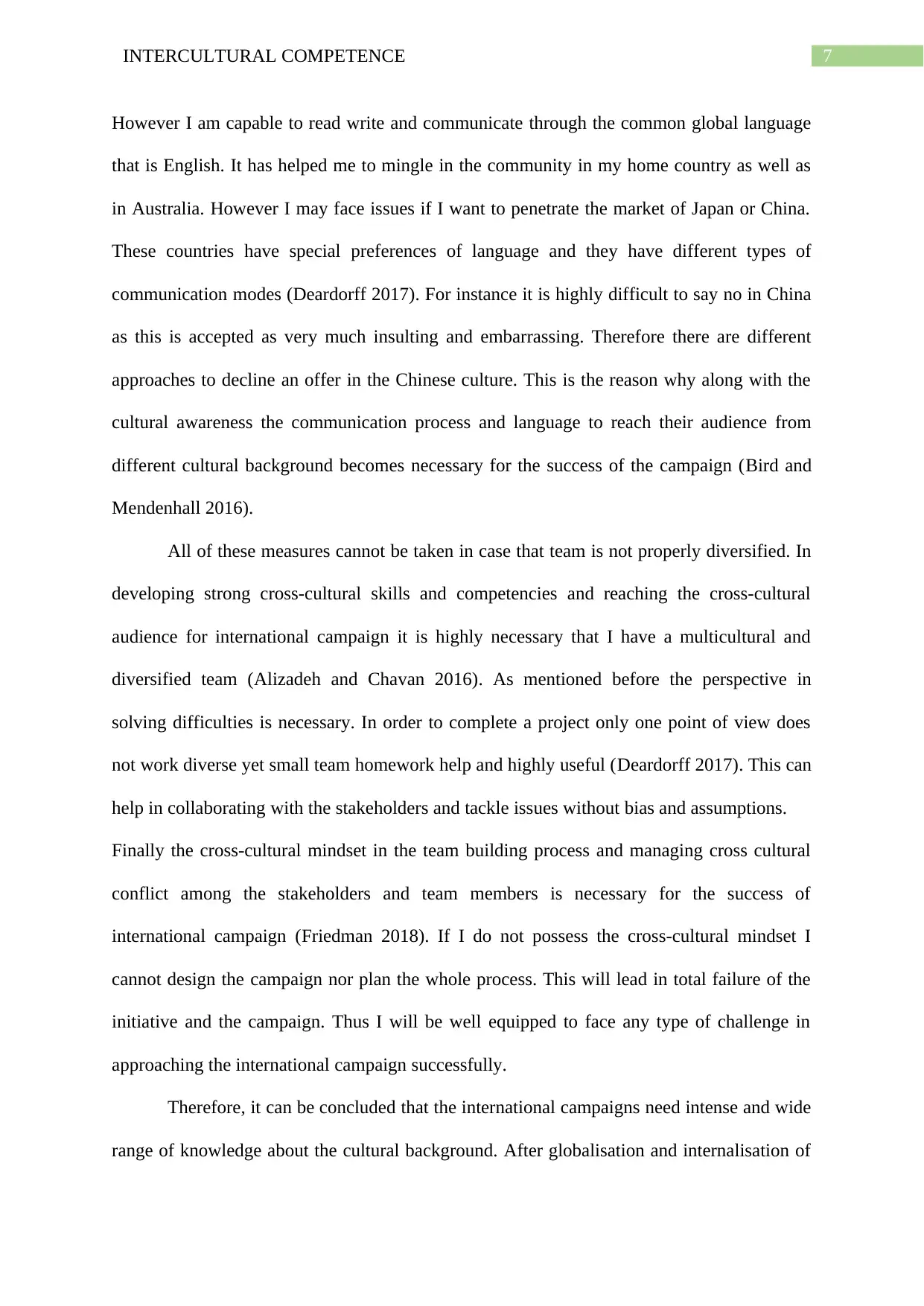
7INTERCULTURAL COMPETENCE
However I am capable to read write and communicate through the common global language
that is English. It has helped me to mingle in the community in my home country as well as
in Australia. However I may face issues if I want to penetrate the market of Japan or China.
These countries have special preferences of language and they have different types of
communication modes (Deardorff 2017). For instance it is highly difficult to say no in China
as this is accepted as very much insulting and embarrassing. Therefore there are different
approaches to decline an offer in the Chinese culture. This is the reason why along with the
cultural awareness the communication process and language to reach their audience from
different cultural background becomes necessary for the success of the campaign (Bird and
Mendenhall 2016).
All of these measures cannot be taken in case that team is not properly diversified. In
developing strong cross-cultural skills and competencies and reaching the cross-cultural
audience for international campaign it is highly necessary that I have a multicultural and
diversified team (Alizadeh and Chavan 2016). As mentioned before the perspective in
solving difficulties is necessary. In order to complete a project only one point of view does
not work diverse yet small team homework help and highly useful (Deardorff 2017). This can
help in collaborating with the stakeholders and tackle issues without bias and assumptions.
Finally the cross-cultural mindset in the team building process and managing cross cultural
conflict among the stakeholders and team members is necessary for the success of
international campaign (Friedman 2018). If I do not possess the cross-cultural mindset I
cannot design the campaign nor plan the whole process. This will lead in total failure of the
initiative and the campaign. Thus I will be well equipped to face any type of challenge in
approaching the international campaign successfully.
Therefore, it can be concluded that the international campaigns need intense and wide
range of knowledge about the cultural background. After globalisation and internalisation of
However I am capable to read write and communicate through the common global language
that is English. It has helped me to mingle in the community in my home country as well as
in Australia. However I may face issues if I want to penetrate the market of Japan or China.
These countries have special preferences of language and they have different types of
communication modes (Deardorff 2017). For instance it is highly difficult to say no in China
as this is accepted as very much insulting and embarrassing. Therefore there are different
approaches to decline an offer in the Chinese culture. This is the reason why along with the
cultural awareness the communication process and language to reach their audience from
different cultural background becomes necessary for the success of the campaign (Bird and
Mendenhall 2016).
All of these measures cannot be taken in case that team is not properly diversified. In
developing strong cross-cultural skills and competencies and reaching the cross-cultural
audience for international campaign it is highly necessary that I have a multicultural and
diversified team (Alizadeh and Chavan 2016). As mentioned before the perspective in
solving difficulties is necessary. In order to complete a project only one point of view does
not work diverse yet small team homework help and highly useful (Deardorff 2017). This can
help in collaborating with the stakeholders and tackle issues without bias and assumptions.
Finally the cross-cultural mindset in the team building process and managing cross cultural
conflict among the stakeholders and team members is necessary for the success of
international campaign (Friedman 2018). If I do not possess the cross-cultural mindset I
cannot design the campaign nor plan the whole process. This will lead in total failure of the
initiative and the campaign. Thus I will be well equipped to face any type of challenge in
approaching the international campaign successfully.
Therefore, it can be concluded that the international campaigns need intense and wide
range of knowledge about the cultural background. After globalisation and internalisation of
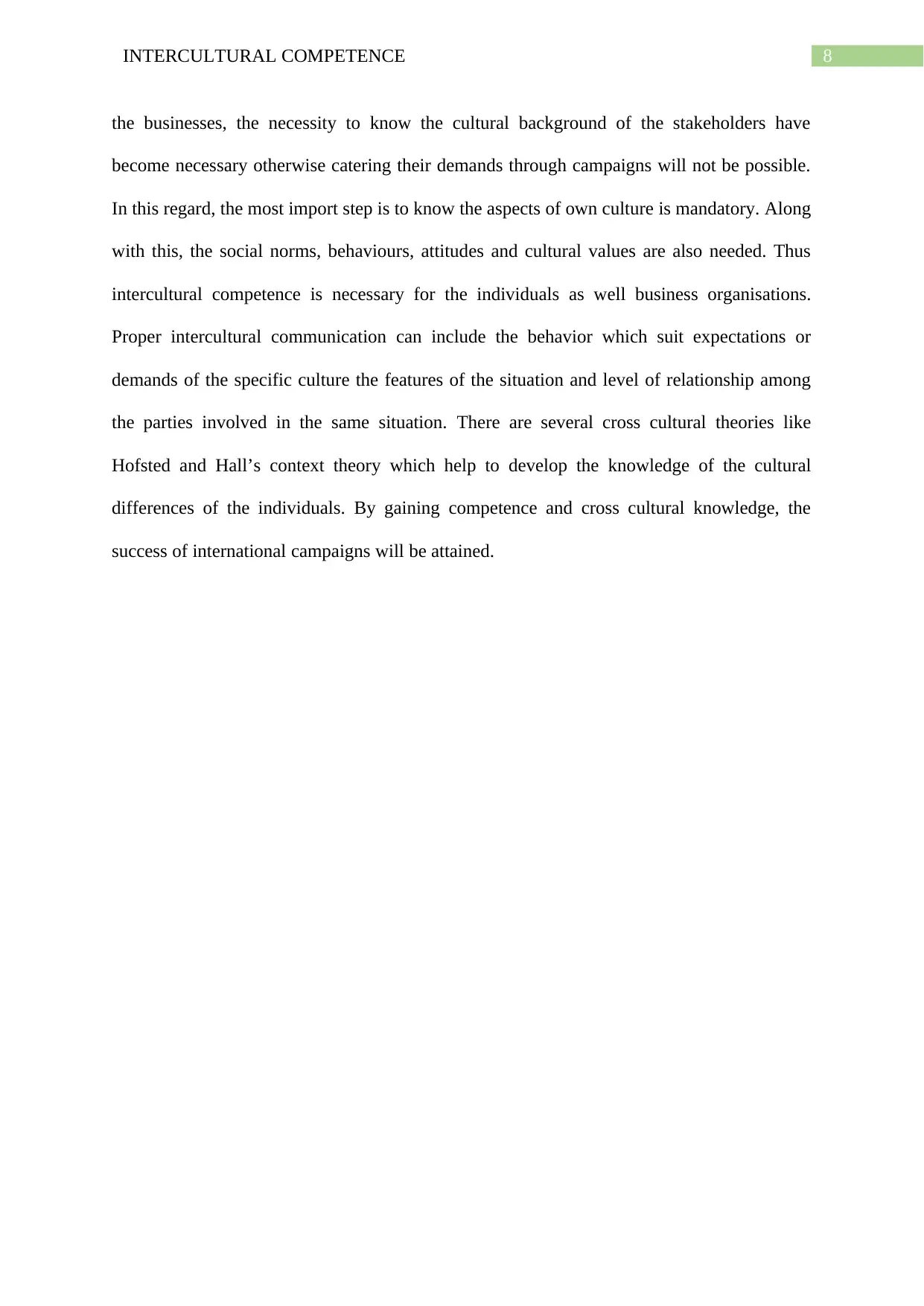
8INTERCULTURAL COMPETENCE
the businesses, the necessity to know the cultural background of the stakeholders have
become necessary otherwise catering their demands through campaigns will not be possible.
In this regard, the most import step is to know the aspects of own culture is mandatory. Along
with this, the social norms, behaviours, attitudes and cultural values are also needed. Thus
intercultural competence is necessary for the individuals as well business organisations.
Proper intercultural communication can include the behavior which suit expectations or
demands of the specific culture the features of the situation and level of relationship among
the parties involved in the same situation. There are several cross cultural theories like
Hofsted and Hall’s context theory which help to develop the knowledge of the cultural
differences of the individuals. By gaining competence and cross cultural knowledge, the
success of international campaigns will be attained.
the businesses, the necessity to know the cultural background of the stakeholders have
become necessary otherwise catering their demands through campaigns will not be possible.
In this regard, the most import step is to know the aspects of own culture is mandatory. Along
with this, the social norms, behaviours, attitudes and cultural values are also needed. Thus
intercultural competence is necessary for the individuals as well business organisations.
Proper intercultural communication can include the behavior which suit expectations or
demands of the specific culture the features of the situation and level of relationship among
the parties involved in the same situation. There are several cross cultural theories like
Hofsted and Hall’s context theory which help to develop the knowledge of the cultural
differences of the individuals. By gaining competence and cross cultural knowledge, the
success of international campaigns will be attained.
⊘ This is a preview!⊘
Do you want full access?
Subscribe today to unlock all pages.

Trusted by 1+ million students worldwide
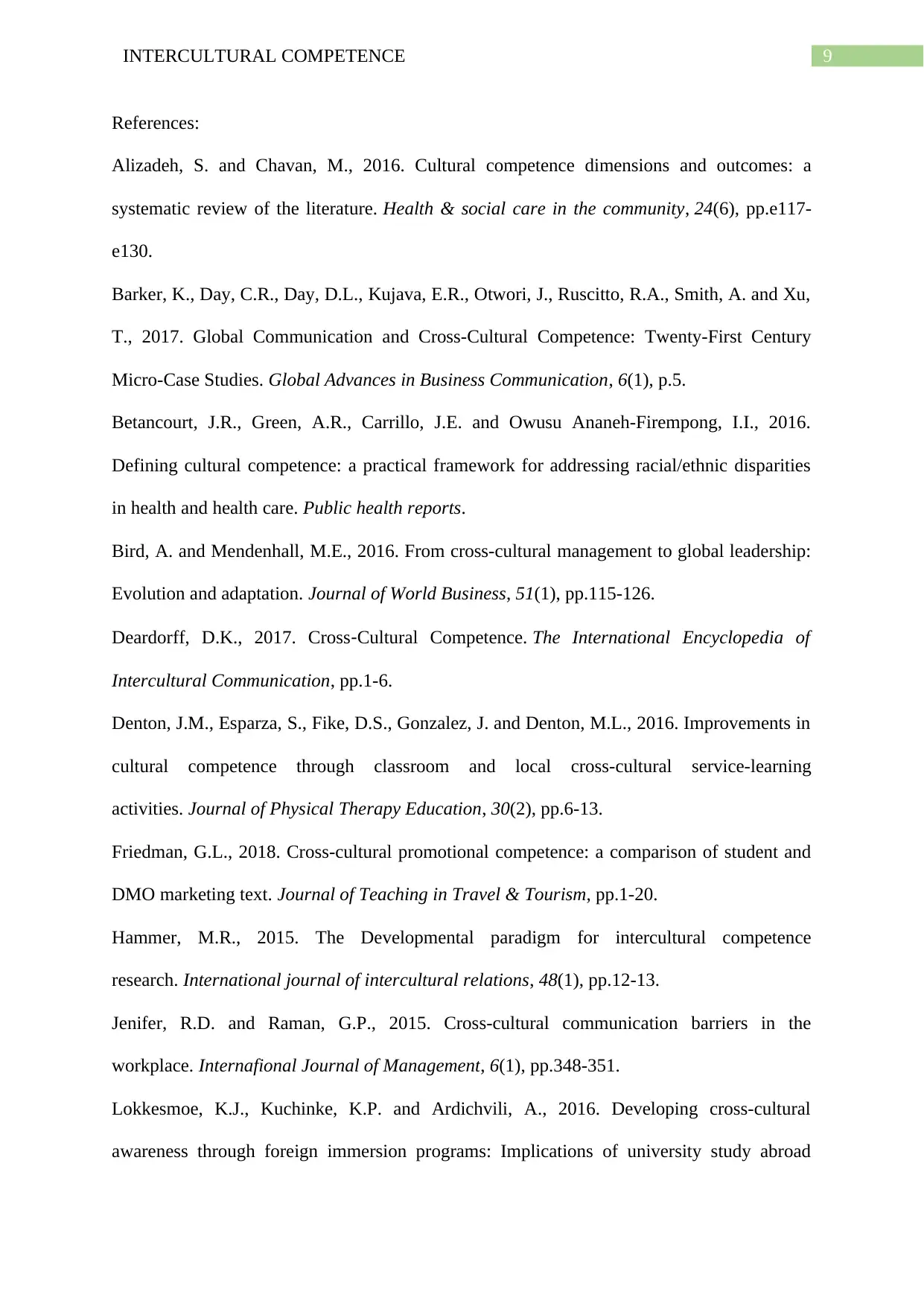
9INTERCULTURAL COMPETENCE
References:
Alizadeh, S. and Chavan, M., 2016. Cultural competence dimensions and outcomes: a
systematic review of the literature. Health & social care in the community, 24(6), pp.e117-
e130.
Barker, K., Day, C.R., Day, D.L., Kujava, E.R., Otwori, J., Ruscitto, R.A., Smith, A. and Xu,
T., 2017. Global Communication and Cross-Cultural Competence: Twenty-First Century
Micro-Case Studies. Global Advances in Business Communication, 6(1), p.5.
Betancourt, J.R., Green, A.R., Carrillo, J.E. and Owusu Ananeh-Firempong, I.I., 2016.
Defining cultural competence: a practical framework for addressing racial/ethnic disparities
in health and health care. Public health reports.
Bird, A. and Mendenhall, M.E., 2016. From cross-cultural management to global leadership:
Evolution and adaptation. Journal of World Business, 51(1), pp.115-126.
Deardorff, D.K., 2017. Cross‐Cultural Competence. The International Encyclopedia of
Intercultural Communication, pp.1-6.
Denton, J.M., Esparza, S., Fike, D.S., Gonzalez, J. and Denton, M.L., 2016. Improvements in
cultural competence through classroom and local cross-cultural service-learning
activities. Journal of Physical Therapy Education, 30(2), pp.6-13.
Friedman, G.L., 2018. Cross-cultural promotional competence: a comparison of student and
DMO marketing text. Journal of Teaching in Travel & Tourism, pp.1-20.
Hammer, M.R., 2015. The Developmental paradigm for intercultural competence
research. International journal of intercultural relations, 48(1), pp.12-13.
Jenifer, R.D. and Raman, G.P., 2015. Cross-cultural communication barriers in the
workplace. Internafional Journal of Management, 6(1), pp.348-351.
Lokkesmoe, K.J., Kuchinke, K.P. and Ardichvili, A., 2016. Developing cross-cultural
awareness through foreign immersion programs: Implications of university study abroad
References:
Alizadeh, S. and Chavan, M., 2016. Cultural competence dimensions and outcomes: a
systematic review of the literature. Health & social care in the community, 24(6), pp.e117-
e130.
Barker, K., Day, C.R., Day, D.L., Kujava, E.R., Otwori, J., Ruscitto, R.A., Smith, A. and Xu,
T., 2017. Global Communication and Cross-Cultural Competence: Twenty-First Century
Micro-Case Studies. Global Advances in Business Communication, 6(1), p.5.
Betancourt, J.R., Green, A.R., Carrillo, J.E. and Owusu Ananeh-Firempong, I.I., 2016.
Defining cultural competence: a practical framework for addressing racial/ethnic disparities
in health and health care. Public health reports.
Bird, A. and Mendenhall, M.E., 2016. From cross-cultural management to global leadership:
Evolution and adaptation. Journal of World Business, 51(1), pp.115-126.
Deardorff, D.K., 2017. Cross‐Cultural Competence. The International Encyclopedia of
Intercultural Communication, pp.1-6.
Denton, J.M., Esparza, S., Fike, D.S., Gonzalez, J. and Denton, M.L., 2016. Improvements in
cultural competence through classroom and local cross-cultural service-learning
activities. Journal of Physical Therapy Education, 30(2), pp.6-13.
Friedman, G.L., 2018. Cross-cultural promotional competence: a comparison of student and
DMO marketing text. Journal of Teaching in Travel & Tourism, pp.1-20.
Hammer, M.R., 2015. The Developmental paradigm for intercultural competence
research. International journal of intercultural relations, 48(1), pp.12-13.
Jenifer, R.D. and Raman, G.P., 2015. Cross-cultural communication barriers in the
workplace. Internafional Journal of Management, 6(1), pp.348-351.
Lokkesmoe, K.J., Kuchinke, K.P. and Ardichvili, A., 2016. Developing cross-cultural
awareness through foreign immersion programs: Implications of university study abroad
Paraphrase This Document
Need a fresh take? Get an instant paraphrase of this document with our AI Paraphraser
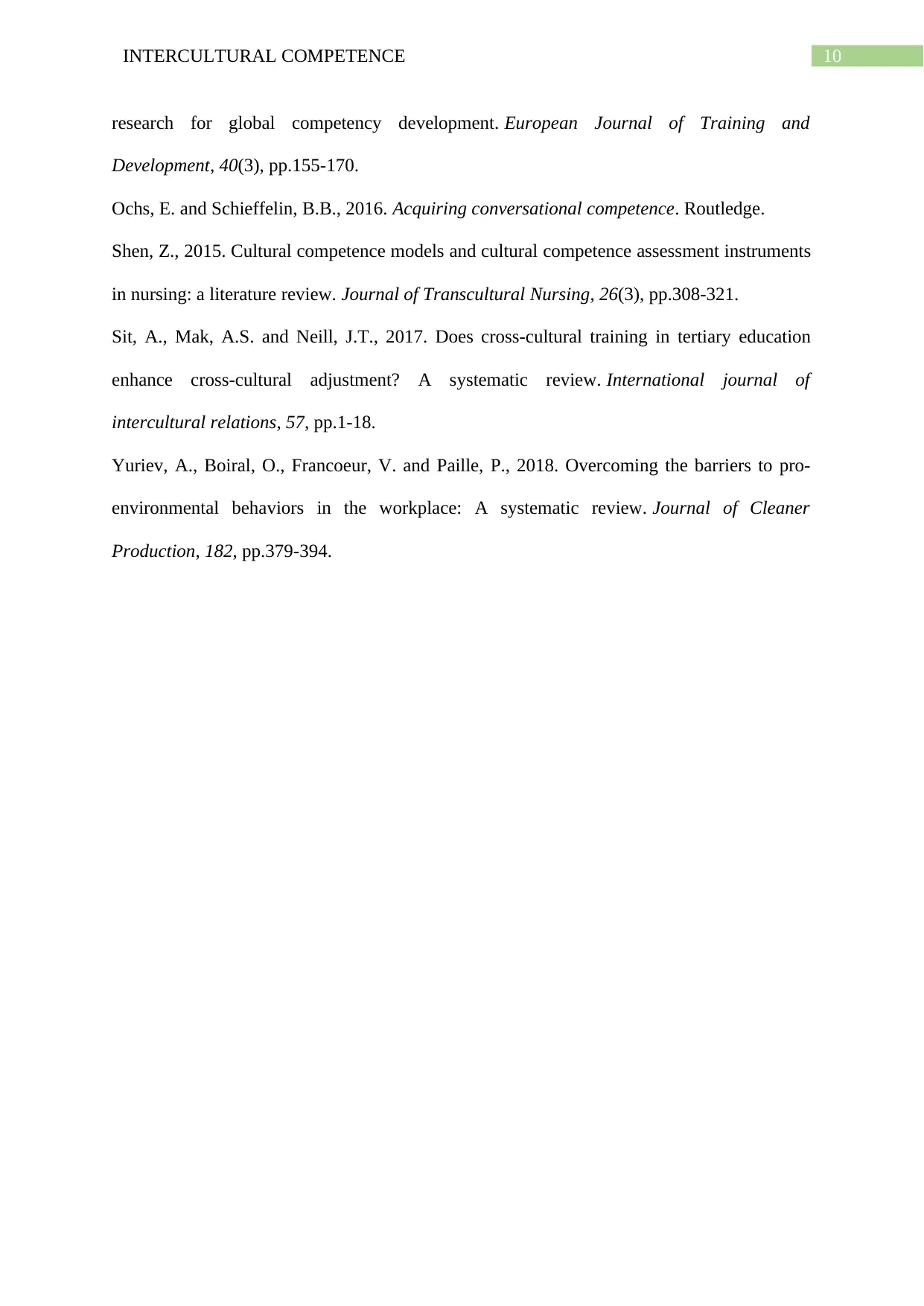
10INTERCULTURAL COMPETENCE
research for global competency development. European Journal of Training and
Development, 40(3), pp.155-170.
Ochs, E. and Schieffelin, B.B., 2016. Acquiring conversational competence. Routledge.
Shen, Z., 2015. Cultural competence models and cultural competence assessment instruments
in nursing: a literature review. Journal of Transcultural Nursing, 26(3), pp.308-321.
Sit, A., Mak, A.S. and Neill, J.T., 2017. Does cross-cultural training in tertiary education
enhance cross-cultural adjustment? A systematic review. International journal of
intercultural relations, 57, pp.1-18.
Yuriev, A., Boiral, O., Francoeur, V. and Paille, P., 2018. Overcoming the barriers to pro-
environmental behaviors in the workplace: A systematic review. Journal of Cleaner
Production, 182, pp.379-394.
research for global competency development. European Journal of Training and
Development, 40(3), pp.155-170.
Ochs, E. and Schieffelin, B.B., 2016. Acquiring conversational competence. Routledge.
Shen, Z., 2015. Cultural competence models and cultural competence assessment instruments
in nursing: a literature review. Journal of Transcultural Nursing, 26(3), pp.308-321.
Sit, A., Mak, A.S. and Neill, J.T., 2017. Does cross-cultural training in tertiary education
enhance cross-cultural adjustment? A systematic review. International journal of
intercultural relations, 57, pp.1-18.
Yuriev, A., Boiral, O., Francoeur, V. and Paille, P., 2018. Overcoming the barriers to pro-
environmental behaviors in the workplace: A systematic review. Journal of Cleaner
Production, 182, pp.379-394.
1 out of 11
Related Documents
Your All-in-One AI-Powered Toolkit for Academic Success.
+13062052269
info@desklib.com
Available 24*7 on WhatsApp / Email
![[object Object]](/_next/static/media/star-bottom.7253800d.svg)
Unlock your academic potential
Copyright © 2020–2025 A2Z Services. All Rights Reserved. Developed and managed by ZUCOL.





